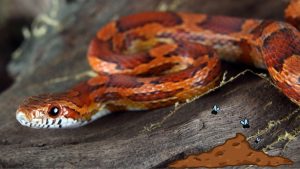Before bringing a gecko into your home, it is crucial to understand its dietary needs. Geckos, like most lizards, are predatory creatures that prefer a varied diet of insects. The specific types of insects, feeding schedule, supplements, and quantity of food required will vary depending on the gecko’s species, age, and activity level.
General Guidelines for Feeding Pet Geckos
Most geckos thrive on a diet of live prey. Unlike dogs and cats, geckos generally do not do well on pre-packaged kibble or prepared food. Therefore, you will need to acquire or breed live insects to feed your gecko.
Some species of pet geckos also consume fruit in addition to insects. These geckos can be fed pureed or prepared fruit mixes formulated specifically for geckos. However, the majority of pet geckos are primarily insectivorous, meaning they primarily eat insects and other small creatures. African fat-tailed geckos, house geckos, and leopard geckos are all exclusively insectivorous. On the other hand, crested geckos and day geckos are frugivorous and consume fruit as part of their diet.
Feeding Your Gecko
Offer a variety of insects to your insectivorous geckos. It is important not to rely too heavily on a single type of insect as this will not provide a complete diet for your gecko.
Crickets: These insects form the main component of most pet geckos’ diets. They are commonly used because they are easy to obtain or raise at home, although they may not be the most nutritious option. Mealworms: Another staple food for leopard geckos, although they may be too large for some species of house geckos. Waxworms and Superworms: These insects are high in fat and should be offered as occasional treats, typically once a week. Flies: Fruit flies are suitable for smaller geckos such as house geckos. They are usually readily available for purchase. In the long term, you may find it more convenient to raise your own crickets and insects for feeding your geckos. Regardless, it is essential to have a proper setup for storing insects to avoid frequent trips to the pet store.
WARNING It is advisable to avoid feeding wild insects to your pet gecko as they may be toxic or contaminated with harmful chemicals from the environment.
Day geckos consume a mixture of the aforementioned insects, particularly crickets, along with gecko diet mix. Similarly, crested geckos typically eat a combination of insects and powdered crested gecko food.
Preparing Your Gecko’s Prey
Ensure that the insects fed to your gecko are well-nourished before offering them. This can be achieved by feeding the insects a nutritious diet for 24 hours prior to feeding them to your pet. Most pet stores sell prepared diets for gut-loading insects. Alternatively, a high-quality mixture of fruits, vegetables, and grains can be used. It is also beneficial to dust the insects with a nutritious powder obtained from a pet store.
For frugivorous geckos, offer fruits such as grapes, apricots, and apples. Puree the fruit or cut it into pieces smaller than the space between your gecko’s eyes. Pieces that are too large can pose a danger to your pet. Prepared fruit mixes for day geckos and crested geckos are available for purchase, making feeding easier. For new gecko owners, it is generally recommended not to create their own fruit mix as it can be challenging to ensure proper calcium and nutrient balance.
Feeding Amount and Schedule
Since most geckos are nocturnal, it is best to feed them at night when they are awake and hungry.
Young geckos should be fed daily, while most adult geckos do well on an every-other-day feeding schedule. Clean, fresh water should always be available to geckos. Regularly misting the enclosure will provide the humidity necessary for your gecko’s well-being.
The quantity of food required by your gecko will depend on its age and activity level. Offer as much food as your gecko will consume eagerly within a few minutes. Avoid putting too many insects in the enclosure, as they may escape, die, or encourage overeating. Introduce one or two insects at a time, reducing the pace as your gecko’s appetite diminishes. Some geckos can be fed using long tweezers, which allows for better control over the number of insects placed in the enclosure.
Remember to remove any uneaten fruit or insects after your gecko has finished eating. Both fruit and insects can rot, leading to an unsanitary environment for your pet.
Author
-

Lawrence, the founder of Pet Ploy, established the website in mid-2023. With a lifelong love for pets, Lawrence has been surrounded by a variety of animals since his early years. From dogs and cats to guinea pigs, rabbits, fish, and more, he has experienced the joy of caring for a diverse range of pets. Drawing from his deep-rooted passion, Lawrence created Pet Ploy to share his knowledge and enthusiasm with fellow pet enthusiasts. Through the platform, he aims to provide valuable insights, tips, and resources to promote the well-being and happiness of pets everywhere.











